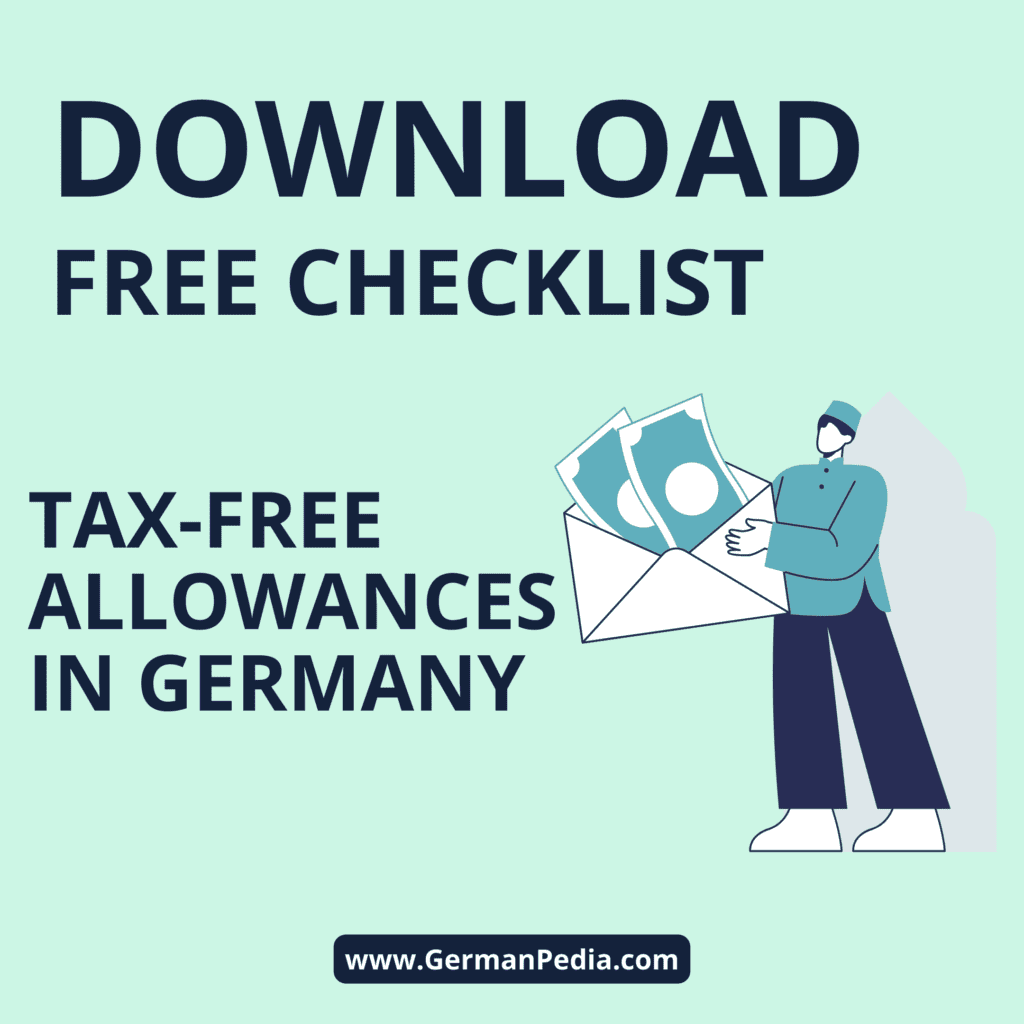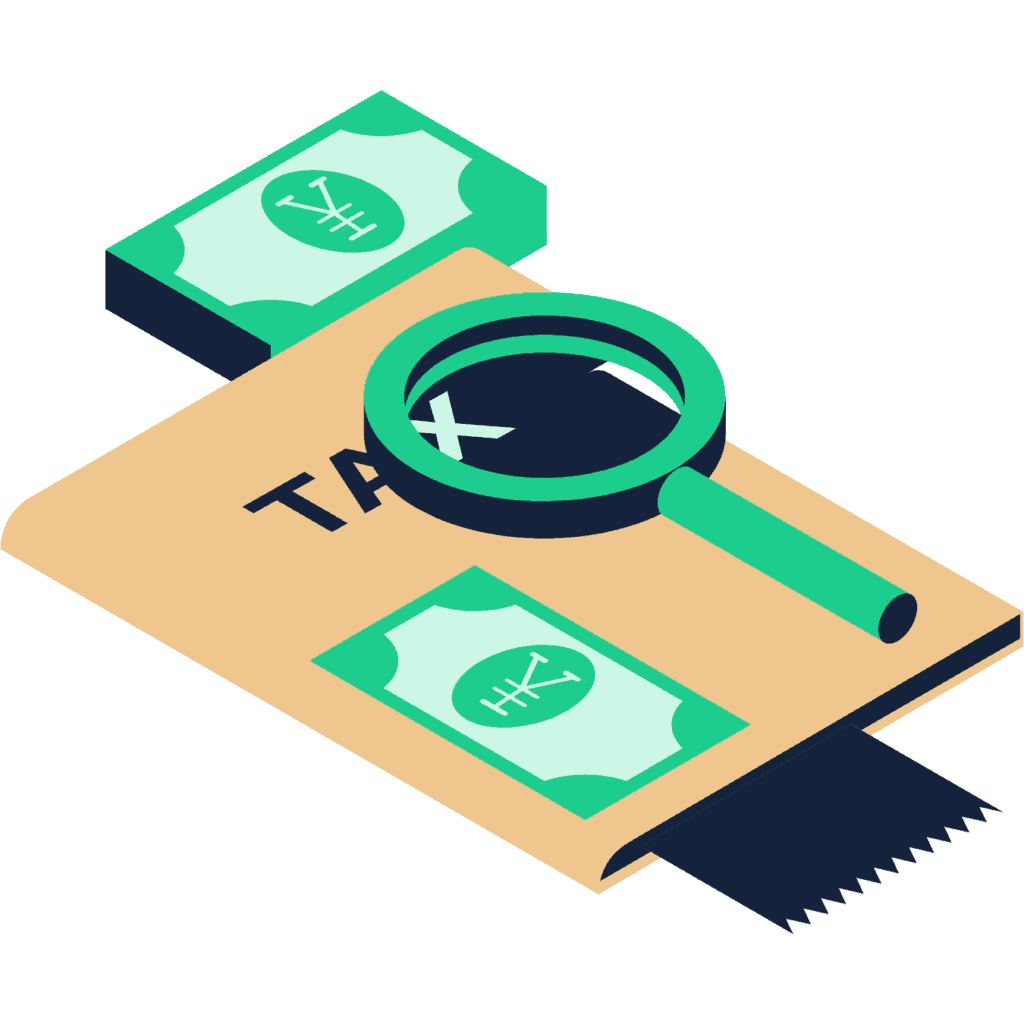Key takeaways
- The German tax system offers several tax-free allowances, flat rates, and tax exemptions to reduce your tax burden.
- You don’t need proof to claim the flat rates in your income tax return.
- You can save, on average, 1095 € in taxes by submitting a voluntary tax return.
- Families with children benefit from child allowances. The tax office offers an additional special relief amount to single parents.
- There are also tax-free allowances for volunteer work, supporting your relatives, caring for your parents, inheritance, etc.
This is how you do it
- Use one of the tax programs to check how much tax return you can expect for free.
- If there is an expected tax return, file the income tax return via the tax app.
- Many online services help you file simple income tax returns in Germany. We find SteuerGo* and Wundertax* among the best tax software.
- We recommend consulting a tax advisor for complex tax returns. You can get a free quote from the tax advisor we recommend here. The tax consultant offers services in English.
Table of Contents
To deduct expenses from taxes, you must provide proof to the tax office. However, German tax law provides many allowances (Steuerfreibetrag) and flat rates (Pauchalen) to reduce administrative work for the tax office.
You can claim these allowances and flat rates without a receipt or invoice.
Certain tax-free allowances, such as the basic or child allowance, apply automatically in Germany. For others, you must fill out an application form.
You can download our checklist for free. It summarizes all the tax-free allowances and flat rates available in the German tax system.
Checklist for tax-free allowances and flat rates

- Download the checklist summarizing all the tax-free allowances and flat rates.
- Maximize your tax savings by claiming tax-free allowances and flat rates without proof.
Tax-free allowance, Tax exemption, Flat rates
The German tax system offers three ways to save taxes without providing proof.
- Tax-free allowances or Tax allowances (Steuerfreibetrag)
- Flat rates (Pauschbetrag)
- Tax exemptions (Steuerfreigrenze)
The tax allowances and Flat rates work similarly. However, tax exemption is different.
What is a tax allowance (Steuerfreibetrag) in Germany?
It’s the amount up to which you pay no taxes. You pay taxes on the income that exceeds the tax allowance.
The tax office offers different tax allowances based on income source, marital status, etc.
Example: You get a tax allowance of 1000€ (from 2024) on your income from capital gains. So, you pay capital gains tax on the profits exceeding 1000€ (from 2024).
What is a flat rate (Pauschbetrag/Pauschalen)?
Flat rates are the expenses you can claim without proof. Flat rates are beneficial for both the taxpayers and the tax office.
- Taxpayers don’t have to save invoices or proofs for small expenses, as they can claim the flat rates without proof.
- Even if you don’t have any expenses, you can still claim the flat rates to save taxes in Germany.
- Flat rates help the tax office reduce its administrative work.
You can also claim expenses exceeding the flat rate on your tax return. However, you must provide proof to the tax office.
Example: Income-related expenses flat rate (Arbeitnehmerpauschbetrag / Werbungskostenpauschale) of 1230€ (as of 2025). It was 1200 € in 2022 and increased to 1230 in 2023.
All employees can deduct 1230€ (as of 2025) without proof from their income. It doesn’t matter if you had these expenses or not.
What is a Tax exemption (Steuerfreigrenzen)?
In tax exemption, you pay no tax if your income is within the limit. However, the tax office taxes your entire income if it exceeds the tax exemption limit.
Example: The tax exemption limit for private sales is 1000 €. You pay no taxes if your income from private sales is under 1000 € in a year. However, the tax office will tax your entire income if you earn a euro more than this limit.
The most important tax allowances in Germany
The table summarizes the tax-free allowances in the German tax system for the past three years.
| Tax-free allowance | 2025 | 2024 | 2023 |
| Relevant for everyone | |||
| Basic tax-free allowance | 12,096€ (in 2025) | 11,784€ (in 2024) | 10,908 € |
| Inheritance tax-free allowance (It depends on your relationship with the person from whom you inherited the money) | Between 20k € and 500k € | Between 20k € and 500k € | Between 20k € and 500k € |
| Trainer’s tax-free allowance | 3000 € | 3000 € | 3000 € |
| Flat rate for volunteer work | 840 € | 840 € | 840 € |
| For families with children | |||
| Child tax-free allowance (Total allowance for a family with one child) | 4,800€ per child per parent (as of 2025) | 4,656 € | 4,476 € |
| Relief amount for single parents | 4,260€ (as of 2025) for the first child and 240€ additionally for each additional child | 4,260 € for the first child and 240 € for each additional child | 4,260 € for the first child and 240 € for each additional child |
| Training allowance | 1200 € | 1200 € | 1200 € |
| Maximum maintenance amount | 12,096€ (in 2025) | 11,784€ (in 2024) | 10,908 € |
| For retired individuals | |||
| Pension tax-free allowance (Decreasing by 0.5% per annum) | 16.5% of your pension | 17% of your pension | 17.5% of your pension |
| For disabled people | |||
| Disability Allowance (Allowance depends on the degree of disability) | Between 384 € to 7400 € | Between 384 € to 7400 € | Between 384 € to 7400 € |
Get a Free Quote From a Tax Advisor

- A tax advisor can help you file an income tax return,
- Change tax class,
- Get a tax residency certificate,
- Support in starting a business,
- Offer services in English
File Income Tax with Wundertax

- 34.99 € for filing a single income tax return
- Tips on deductible costs & plausibility check
- Try it out for free & only submit if you’re fully satisfied
- Also available in English
File Income Tax with SteuerGo

- 34.95 € for filing a single income tax return
- Easy to file and save tax.
- The tool is also available in English.
- Get tax-saving tips to maximize your tax return in the current and the following years.
Let’s learn about each tax-free allowance in detail.
#1 Basic tax-free allowance (Grundfreibetrag)
Everyone in Germany is entitled to the basic allowance (Grundfreibetrag). You pay taxes on the income that exceeds the basic tax-free allowance.
| Basic allowance | 2022 | 2023 | 2024 | 2025 |
| Single | €10,347 | €10,908 | 11,784€ (in 2024) | 12,096€ (in 2025) |
| Married couples | €20,694 | €21,816 | €23,568 | 24,192€ (in 2025) |
The idea behind the basic allowance is that every citizen must have a minimum tax-free income for minimum subsistence.
#2 Child allowance (Kinderfreibetrag)
A child allowance is like a basic allowance. It’s the amount required for a child’s minimum subsistence.
The child allowance consists of two parts.
- Child tax allowance
- Allowance for care and upbringing or training needs (Betreuungsfreibetrag (BEA allowance))
These are always shown as a total and are generally referred to as the child allowance. The child allowance further reduces the taxable income.
However, the tax authorities only consider the child allowance if the savings are higher than the child benefit you received during the year.
The tax office automatically determines which is more advantageous for you in the so-called family benefit adjustment. The table below shows how much the child allowance is in Germany.
| 2023 | 2024 | 2025 | |
| Child tax allowance | 3,012 € per parent | 3,192 € per parent 3,306 € per parent1 | 3,336€ per child per parent (as of 2025) |
| BEA allowance | 1464 € per parent | 1464 € per parent | 1,464€ per child per parent (as of 2025) |
1increased retroactively as of 1 Jan 2024
The total child allowance per child.
| 2023 | 2024 | 2025 | |
| Single | 4,476 € | 4,656 € 4,770 €1 | 4,800€ per child per parent (as of 2025) |
| Married | 8,952 € | 9,312 € 9,540 €1 | 9,600 € |
1increased retroactively as of 1 Jan 2024
The child benefit (Kindergeld) is 250 € per month for each child from 1 Jan 2023. The government increased it to 255€ per month per child (as of 2025).
#3 Relief amount for single parents (Entlastungsbetrag für Alleinerziehende)
The German government offers a special tax relief amount to single parents. You are eligible for this amount if you fulfill the following criteria.
- You are raising a child for whom you are entitled to child benefits or a child allowance
- You are raising the child alone
- Your child and you live in the same household
The relief amount for single parents is 4,260€ (as of 2025) for the first child and 240€ additionally for each additional child. You must apply for the relief amount in your tax return.
You can also change your tax class to tax class 2. This will increase your net salary, as the tax office will consider the relief amount when deducting income tax from your salary.
#4 Training allowance (Ausbildungsfreibetrag)
You get the training allowance for your child if you meet the following criteria.
- Your child is in training
- Your child doesn’t live with you in the same household
- Your child is of legal age
- You receive child benefits or child allowance for the child
The training allowance increased to 1200 € in 2023. It was 924 € earlier. You can apply for the training allowance in your tax return by filling out the child appendix.
Suppose you don’t meet the training allowance requirements for the entire year. In this case, the allowance will be reduced on a monthly basis.
#5 Maximum maintenance amount (Unterhaltshöchstbetrag)
If you support your parents or relatives financially, you can deduct such maintenance payments as extraordinary expenses up to the maximum amount.
Example: Your parents must go into a nursing home due to their age. You pay for the nursing home. In this case, you can deduct the expenses from taxes.
The maximum maintenance amount corresponds to the basic allowance. So, it’s 12,096€ (in 2025).
#6 Pension allowance (Rentenfreibetrag)
The pension allowance is the percentage of statutory pension that is tax-free. For people retiring in 2025, it is 16.5%. This means 16.5% of your pension is tax-free.
However, the pension allowance is decreasing by 0.5% per annum. So, the pension allowance for people retiring in 2026 will be 16%, and 15.5% for the ones retiring in 2027.
The pension allowance decreased by 1% earlier. However, starting in 2023, it’ll decrease by 0.5% (as per the Growth Opportunities Act (Wachstumschancengesetz)).
The pension allowance will be 0 for people retiring in 2058 and onwards. This means you have to pay taxes on your entire pension.
#7 Tax-free allowances for people with disabilities (Behindertenpauschbetrag)
Disabled people are entitled to the disability allowance. Depending on the degree of disability, the allowance is between 620 € and 7,400 € per year.
If you can prove higher expenses due to the disability, you can claim the full amount as extraordinary expenses in the tax return. However, only the amount exceeding the reasonable burden is considered for tax purposes.
You can also deduct the costs of caring for a disabled or dependent family member as a household-related service from your taxes.
Additionally, disabled people can claim the distance allowance for the two-way journey to work instead of only a one-way route.
The table below shows the disability allowance based on the degree of disability.
| Degree of disability | Tax-free allowance |
| 20 | €384 |
| 30 | €620 |
| 40 | €860 |
| 50 | €1,140 |
| 60 | €1,440 |
| 70 | €1,780 |
| 80 | €2,120 |
| 90 | €2,460 |
| 100 | €2,840 |
| Blind / deaf | €7,400 |
#8 Inheritance tax-free allowance (Freibeträge bei der Erbschaftssteuer)
The inheritance allowance depends on how closely you are related to the person from whom you inherited wealth. The closer the relation, the higher the tax-free allowance.
You can claim the inheritance tax-free allowance every 10 years. The table below shows the tax-free allowance based on your relationship with the person from whom you inherited the wealth.
| Family relationship | Tax-free allowance |
| Spouse or civil partner | €500,000 |
| Child or stepchild | €400,000 |
| Grandchild whose parents are no longer alive | €400,000 |
| Grandchild whose parents are alive | €200,000 |
| Great-grandchild | €100,000 |
| All other relatives | €20,000 |
#9 Trainer tax-free allowance (Übungsleiterfreibetrag)
If you earn extra money part-time as a trainer, artist, or carer, you can benefit from the trainer allowance. The trainer allowance is 3,000 € (until 2020: 2,400 €).
You pay taxes on the amount that exceeds the trainer allowance, i.e., 3000 €. However, you must fulfill the following requirements to get it.
- You work part-time for a public or non-profit organization.
- Your work should be around education and training.
If your main job is an employee, enter the trainer allowance in Appendix N of your tax return. Self-employed people indicate the tax-free amount as “Tax-free self-employed activities in a secondary occupation” in Appendix S.
#10 Flat rate for volunteer work (Ehrenamtspauschale)
You can benefit from the volunteer allowance if you volunteer in an area, such as a retirement home, a youth hostel, etc. The tax-free allowance for volunteer work is 840 € per year.
You can claim the flat rate by mentioning it in Appendix N (as an employee) or Appendix S (as a self-employed person).
Moreover, you can claim both “trainer allowance” and “volunteer flat rate,” but not for the same activity.
For example, suppose you work as a sports club trainer and manage the club’s treasury. In this case, you can claim a trainer allowance for your work as a trainer and a flat rate for your work as the club’s treasurer.
What flat rates (Pauschbetrag) are there in the German tax system?
The table summarizes the important flat rates (Pauschbetrag) in the German tax system.
| Flat rates | 2025 | 2024 | 2023 |
| Employee flat rate | 1230 € | 1230 € | 1230 € |
| Home office flat rate | 6 € per day (up to 1260 € ) | 6 € per day (up to 1260 € ) | 6 € per day (up to 1260 € ) |
| Travel allowance | 30 cents per km for the first 20 km and 38 cents per km from the 21st km | 30 cents per km for the first 20 km and 38 cents per km from the 21st km | 30 cents per km for the first 20 km and 38 cents per km from the 21st km |
| Pension flat rate | 102 € | ||
| Meal allowance | 14 € for business trips longer than 8 hrs. 28 € for business trips longer than 24 hrs. | 14 € for business trips longer than 8 hrs. 28 € for business trips longer than 24 hrs. | 14 € for business trips longer than 8 hrs. 28 € for business trips longer than 24 hrs. |
| Relocation flat rate | 964 € plus 643 € for each additional family member (from 1 March 2024) | 964 € plus 643 € for each additional family member (from 1 March 2024) | 886 € plus 590 € for each additional family member |
| Saver’s flat rate or capital gains tax-free flat rate | 1000 € | 1000 € | 1000 € |
| Special expenses flat rate | 36 € for singles and 72 for married couples | 36 € for singles and 72 for married couples | 36 € for singles and 72 for married couples |
Let’s understand each tax flat rate in detail.
#1 Employee flat rate (Arbeitnehmer-Pauschbetrag)
Every employee in Germany can deduct an “employee flat rate” from their income tax return. This is also known as a flat rate for income-related expenses.
The employee flat rate is 1230€ (as of 2025). It was 1,200 € in 2022 and increased to 1230 € in 2023.
The tax authorities automatically deduct the “employee flat rate” while calculating the tax. So you don’t have to do anything.
If your income-related expenses exceed the flat rate, you must claim them while filing the tax return.
Tip: You should save thereceipts of your work-related expenses. You will be surprised how quickly the small bills can add up to a big amount.
#2 Home office flat rate (Homeoffice-Pauschale)
The German finance office modified the home office tax law after Corona. Initially, the home office flat rate was intended to be valid by the end of 2022.
However, in 2023, the tax office made the home office flat rate permanent. In addition, the home office flat rate was increased to 6 € per day, and the number of days was also increased to 210.
This brings the total home office allowance to 1,260 € from 2023. So, you can deduct 1260€ (in 2024 tax year) as if you worked form home.
#3 Travel allowance (Entfernungspauschale)
You can claim the travel allowance of 30 cents per kilometer for travel to your workplace. The distance allowance increases to 38 cents per km from the 21st kilometer onwards.
The tax office considers the one-way distance between the home and work while calculating the distance allowance.
Example: Suppose the one-way distance between your home and work is 25 km, and you traveled to the office for 228 days. In this case, you can claim 30 cents per km for the first 20 km and 38 cents per km for the rest.
So, you can deduct 1664 € ((20 * 0.30 * 228) + (5 * 0.38 * 228)) as travel costs from the taxes as per this example.
Usually, the travel costs (distance allowance) already exceed the “employee flat rate.” Thus, you can deduct other income-related expenses from the tax return.
#4 Pension flat rate (Pauschbetrag für Renten)
If you receive pension benefits, you can claim a pension flat rate for income-related expenses of 102 €. The tax office deducts the pension flat rate automatically from your income.
You can receive the two flat-rate amounts of 1230€ (as of 2025) and 102 € side by side if you receive wages and pension benefits at the same time.
#5 Meal allowance (Verpflegungspauschale)
You can claim the meal allowance if you travel for more than 8 hours for work within Germany. The flat rate varies based on the number of hours you were on the business trip.
- The meal allowance is 14 € if you are on a business trip for over 8 hours.
- The allowance increases to 28 € if you are on a business trip for more than 24 hours.
- You can always claim 14 € for the arrival and departure days, regardless of the duration.
Attention: The German federal government planned to increase the meal allowance to 32 or 16 € in 2024. However, the plan has been canceled.
The meal allowance flat rates vary for travel abroad and even vary within one country. The BMF letters provide a complete list of meal allowances per country.
- Meal allowance for foreign countries in 2025
- Meal allowance for foreign countries in 2024
You cannot claim higher meal costs, even if you have collected restaurant bills.
#6 Relocation flat rate (Umzugskostenpauschale)
You can claim the actual relocation costs or the flat rate if you relocate for professional reasons. From 1 March 2024, the relocation flat rate is [].
Read our guide on how to deduct relocation costs from taxes.
#7 Saver’s flat rate (Sparerpauschbetrag)
You get a saver’s flat rate of 1000€ (from 2024) for income from stocks and interests. This means you don’t pay any taxes on capital gains up to 1000€ (from 2024).
#8 Special expenses flat rate (Sonderausgaben-Pauschbetrag)
You get a flat rate of 36 € for special expenses for singles or 72 € for married couples. As the flat rate for special expenses is quite low, you can deduct expenses such as donations, childcare expenses, maintenance payments, etc.
Get a Free Quote From a Tax Advisor

- A tax advisor can help you file an income tax return,
- Change tax class,
- Get a tax residency certificate,
- Support in starting a business,
- Offer services in English
What tax-free allowances apply automatically?
The tax office applies the following tax allowances automatically. You don’t have to do anything.
- Basic tax-free allowance (Grundfreibetrag)
- Employee flat rate (Arbeitnehmer-Pauschbetrag)
- Pension flat rate (Pauschbetrag für Renten)
- Child allowance (Kinderfreibetrag)
More topics
- How to save taxes in Germany?
- Tax ID and number
- Change tax class
- Capital gains tax in Germany
- Deduct relocation costs from taxes
- Types of taxes you pay in Germany
- How much money does the German government collect in the form of taxes?
- Is filing a voluntary tax return worth it?
- What income-related costs can you deduct from taxes in Germany?
- Avoid double taxation in Germany
- Do you pay tax on income from outside Germany?
- Deduct medical expenses from taxes in Germany
References
- https://www.vlh.de/wissen-service/steuer-abc/was-ist-der-betreuungsfreibetrag.html
- https://www.steuerbot.com/ratgeber/steuerwissen/steuerfreibetrag
- https://www.finanztip.de/freibetraege-pauschbetraege/
- https://www.handelsblatt.com/finanzen/steuern-recht/steuern/steuererklaerung-diese-steuerfreibetraege-gelten-2023-und-2024/28953830.html
